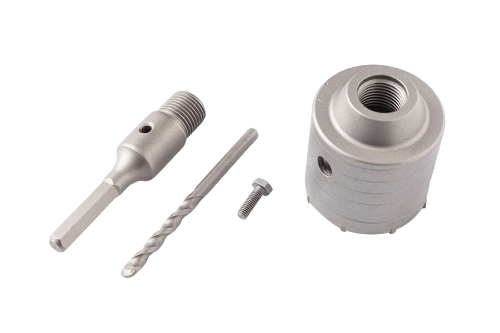The primary purpose of hammer drill bits is to be used with a hammer drill, a power tool designed for drilling into hard materials such as concrete, masonry, stone, or brick. Hammer drill bits are specifically engineered to withstand the hammering action of the drill while effectively drilling through tough surfaces.
Here's how hammer drill bits work and their main features:
Design and Material: Hammer drill bits are made from high-quality materials, such as hardened steel, carbide, or other durable alloys. They are specially engineered to withstand the powerful forces generated by the hammer drill's hammering action.
Special Tip Design: The tip of a hammer drill bit is its most critical part. It is usually made of carbide, which is extremely hard and can endure the repeated impact of the hammer drill. The tip is designed in various ways, depending on the application and material being drilled. Common tip designs include:
Pointed Tip: Used for general-purpose drilling in materials like wood, plastic, and metal.
Flat Tip (Chisel Tip): Suitable for chipping away at materials like concrete and masonry.
Spiral Tip: For faster and more efficient drilling in softer masonry materials.
Hammering Action: When the hammer drill is activated in the hammer mode, it engages a mechanism that causes the drill bit to move back and forth rapidly while rotating. This creates a hammering or pounding effect, allowing the bit to break through the tough surface of the material being drilled.
Rotary Motion: In addition to the hammering action, the hammer drill bit also rotates like a regular drill bit. This combination of hammering and rotary motion enables the bit to penetrate and remove material effectively.
Drilling into Tough Materials: When drilling into hard materials like concrete or masonry, the hammering action of the hammer drill bit breaks up the surface, while the rotary motion helps to remove the debris from the hole, allowing for a smooth and efficient drilling process.
Cooling and Lubrication: Drilling into tough materials generates heat and friction, which can cause the drill bit to overheat. Some hammer drill bits have special features like fluting or spiral designs that help with cooling and lubrication, reducing heat buildup and extending the life of the bit.
Selection and Maintenance: To achieve the best results and prolong the life of your hammer drill bits, it's essential to select the appropriate bit for the material you're drilling into and to keep the bits clean and sharp. Dull or damaged bits can result in less efficient drilling and may cause excessive wear on the hammer drill itself.
The most common applications of hammer drill bits include:
Concrete and Masonry Work: Hammer drill bits are extensively used for drilling holes in concrete walls, floors, and ceilings during construction and renovation projects.
Installing Anchors: When securing objects to concrete or masonry surfaces, such as wall anchors, screws, or dowels, hammer drill bits are essential for creating precise and secure holes.
Brick and Stone Drilling: They are also useful for drilling into brick and natural stone, where regular drill bits might struggle due to the hardness of the materials.




 English
English
 中文简体
中文简体
 Español
Español
 عربى
عربى












